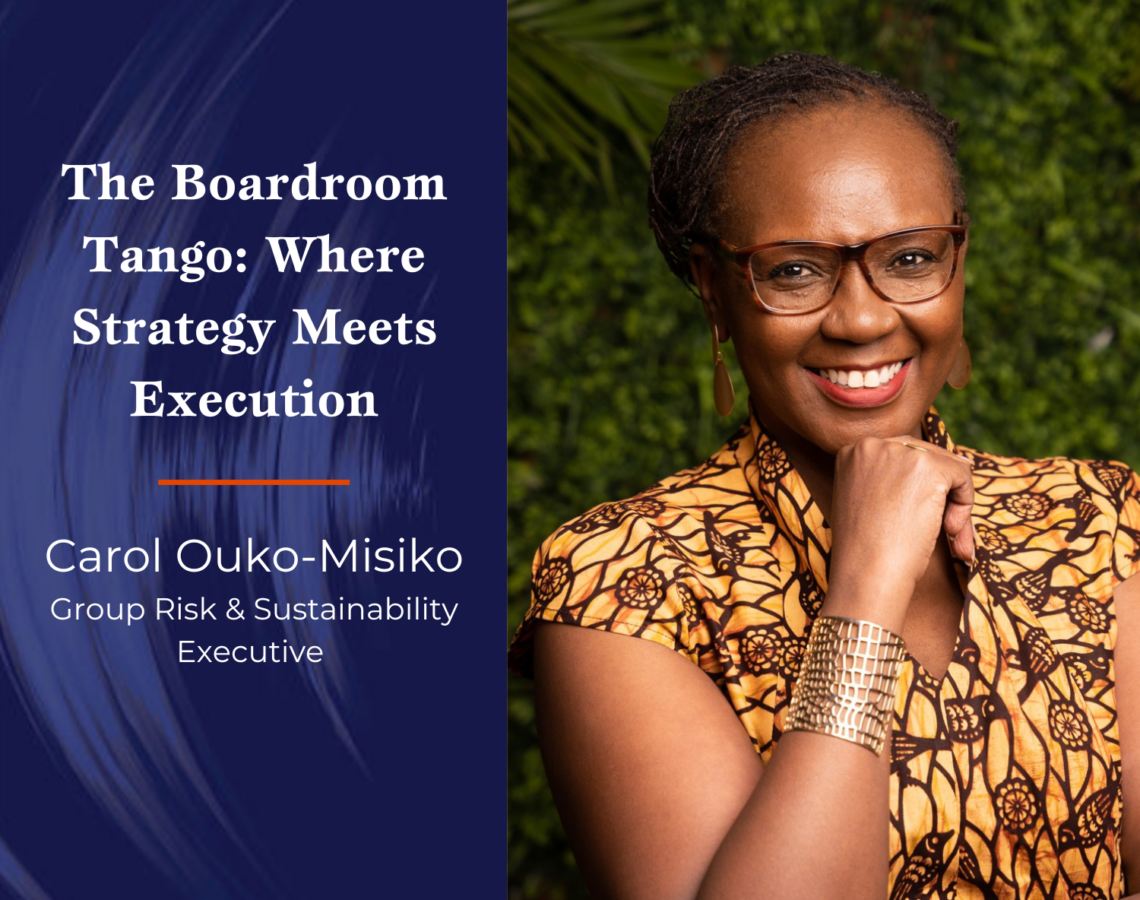The Boardroom Tango: Where Strategy Meets Execution

The boardroom Tango is where strategy meets execution, highlighting the dynamic dance between the board and executives in steering an organization. But what does an executive have to do in order to really get the most out of non-executives? How does this dance between the two work? How can it be influenced and improved?
In this podcast, Dr Sabine Dembkowski, Founder and Managing Partner of Better Boards, discusses the boardroom tango with Carol Ouko-Misiko, who is an experienced and enthusiastic leader in sustainability and enterprise risk management with over 20 years of experience transforming organisations across East Africa and beyond. Currently Group Sustainability and Risk Executive for Old Mutual Plc East Africa, she oversees 11 business units in the financial services sector, domiciled in 4 countries in East Africa. Before that, she was the Director of Risk and Audit for Britam Holdings Plc, with operations in 7 countries in East and Southern Africa. A founding member and Secretary of the Institute of Risk Management East Africa Chapter, she is a member of the leadership of the Compliance Society of Kenya and a member of the WEF Global Risk Report Advisory Board.
“If I had to choose, I’d rather be where the magic is happening”
Carol starts by explaining that if she had to choose between executive and board member roles, she would always prefer the driver’s seat as an executive. Executives have the opportunity to take strategy and turn it into tangible outcomes, leading teams, navigating uncertainty, and shaping the future, and she believes that’s where the real impact happens.
Reflecting on her early days on the board, one challenge stands out—curating information. Distilling complex information into clear, actionable insights takes effort and discipline; as an executive, she initially struggled with this. It’s easy to be overwhelmed with data but far harder to refine information to enable thoughtful decision-making. The key is balance—enough detail for clarity but not so much that it clouds judgment. Effective board development relies on ensuring the right level of detail to facilitate strategic discussions while avoiding unnecessary complexity.
“It’s that delicate balance between a nose in, hands out approach”
The relationship between the board and management is a dynamic one. The board actively participates in governance, approves strategy, and maintains a firm grip on its fiduciary responsibilities. This is often characterised as a “nose in, hands out” approach, with board members highly engaged in significant decisions, risk evaluation, and executive performance but must also avoid micromanaging daily operations. Their role is to govern, not to manage, placing trust in executives to execute strategy effectively. However, challenges arise, and circumstances sometimes demand a more active role when an organisation faces significant change or distress, whether financial, structural, or transformational. In such cases, Carol accepts that a “hands-in” approach may be necessary. The balance between oversight and involvement is delicate; the right approach depends on the situation.
For Carol, transitioning from an executive role to a non-executive board position brought challenges because, having spent much of her career leading from the front, stepping back into a governance role required a shift in mindset. She acknowledges that she has been fortunate to work with experienced board members who have guided her through complex transitions, sharing their insights and helping her maintain perspective. She has also experienced the intensity of organisational change firsthand, with some efforts successful and others less so. The board’s ability to provide a broader view has been invaluable in those moments. When deeply involved in execution, it is easy to lose sight of the bigger picture. A well-functioning board ensures leadership stays focused on long-term strategy rather than getting lost in immediate challenges.
“Do we have the meeting before the meeting? I think it’s necessary, but it can’t replace opportunities for us to face issues without the bias”
For Carol, the meeting before the meeting is something she loves and hates – they feel counterintuitive. Yet, she has come to recognise their value because they provide an opportunity to break the ice, easing difficult conversations before they take place in a formal setting. These informal discussions help build rapport, align perspectives, and create consensus, especially when sensitive topics are on the agenda. However, Carol remains cautious about their potential downsides because pre-meetings can undermine transparency, bypass formal governance protocols, and discourage open, rigorous debate if misused. If board members become too reliant on informal discussions, there is a risk that critical issues will not receive the full scrutiny they require. The challenge is ensuring that these conversations support decision-making without replacing the necessary formal discussions which test different viewpoints without bias.
For Carol, the most crucial pre-meeting conversation is always with the board chair, and that relationship needs to be open and candid, without barriers. Beyond that, she sees value in engaging with fellow board members to create an informal space where concerns can be aired and perspectives shared. While these discussions can be beneficial, they should never become a substitute for structured, robust governance and disciplined decision-making.
“You need to have a bit of thick skin and a sharp focus”
For an executive to succeed in the boardroom, resilience and focus are essential. Carol believes that executives must develop a thick skin and a sharp focus, but beyond that, they also need the ability to frame a compelling narrative. Rallying people around a vision or strategy is not just about presenting facts; it’s about storytelling. As non-executive board members are not involved in day-to-day operations, executives must articulate a clear, urgent case for action. A well-crafted narrative drives meaningful engagement and momentum. Carol has come to appreciate that success in the boardroom is not about arriving with all the answers. The ability to listen, admit gaps in knowledge, and draw from the experience of non-executives is a mark of strong leadership, and emotional intelligence and self-awareness are also critical, as board members bring diverse perspectives.
Carol also credits mentorship as a key factor in long-term success. Having the right people for guidance and support is invaluable in shaping leadership growth. Board interactions should not be purely transactional; they should be focused solely on reviewing papers and checking items off an agenda. While structure and choreography of board meetings are necessary, they often leave little room for organic discussions that spark deeper insights and challenge conventional thinking. Some of the most valuable exchanges come from those informal, unplanned moments where real conversations happen.
“The most valuable input that a non-exec has done has been to engage”
Carol recalls reading an article outlining the roles a non-executive board member can play. In her experience, the most valuable non-executives engage across all these roles, adapting their approach based on the situation. The first role is that of a mentor, where a non-executive provides constructive feedback, asks insightful questions, and proposes recommendations in the early stages of a discussion. The second is a partnering role, where they actively gather information before meetings and contribute meaningfully to discussions. The third is a more controlling function, where they step in on issues such as shareholder concerns or capital management. Finally, there is the more passive role, where they observe and provide oversight without direct intervention. Carol values most when a non-executive knows how to calibrate their engagement, shifting between these roles as needed, as the ability to adjust based on the level of risk, complexity, or urgency of an issue brings real value. A non-executive who can balance mentoring, active participation, and governance oversight creates richer, more meaningful board interactions and ultimately strengthens decision-making.
The three top takeaways for effective boards from our conversation are:
- The boardroom is a lifelong dance – Executives and non-executives are in this for the long haul. Success comes from practice, patience, and constant adjustment.
- Clarity is the choreography – The boardroom works best when information is simple yet powerful, allowing everyone to move in sync.
- Constructive tension fuels success – Executives bring drive, non-executives bring perspective, and together, they create a partnership that keeps the organisation moving forward.
Remember to subscribe and never miss an episode of the Better Boards Podcast Series. It’s available on Apple, Spotify, or Google.
To find out how you can participate in the Better Boards Podcast Series or for more information on Better Boards’ solutions, please email us at info@better-boards.com.



